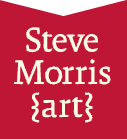Buffy the Vamire Slayer cover, issue 30 season 10
Acrylic on paper 13.5"w x 19.5"h.
Towards the end of season 10 I thought I might like to traditionally paint the finale cover. Since I'd been turning in covers ahead of schedule, I felt that I had enough time to attempt a painting.
I started with a detailed color sketch in Photoshop (below), putting in more time than usual at this stage to make sure that the color/composition was nailed down ahead of time. I also considered the digital sketch a fallback…if I didn't like the painting, I could jump to PS and turn the sketch into a final cover like normal.
Digital color sketch for painting.
Once I was happy with the digital sketch, I imported the image into Illustrator and printed it as a tiled image (four pieces of paper), at the size I wanted the final painting. Taping together the four pieces of paper proved to be a trickier than expected because the printer wasn't printing square on the paper. I used a light box to get the image aligned as I taped.
The watercolor paper, that I planned to paint on, was too thick to see the sketch through when stacked on a light box, so I used the graphite transfer method. Using an ebony pencil and light box, I scribbled on the back of the tiled sketch, making sure to get graphite on all the details. Then I taped the paper onto the watercolor paper, lining up the corners of the print with the bounding box I had drawn on the wc paper. I carefully penciled over the sketch, outlining all the important shapes and features. In the image below you can see the pencil lines I drew over the printed image. Now the image has been transferred to the good paper. At this point some artist may clean the line work up, since the transferred graphite lines are always a little wobbly…I decided to move to the painting instead.
Tiled image on four pieces of paper.
I don't approach the start of a painting the same way each time…In this case, I started with an light ochre wash. I thought I'd like the ochre showing through the blue, but it's wasn't working they way I wanted, and it required several layers of blue to overcome the yellow. I blocked out the rest of the painting, being careful around the face to retain the particulars of the features.
Cover painting inprogress.
I intended to take several pictures of my progress but with a string of overcast days and the speed at which I painted, I ended up with only one progress shot. The painting was completed in a about 4 days and then spent a few weeks, knit picking and making adjustments bit by bit.
When I first tried to shoot the painting, I noticed a red day-glow effect on Buffy's skin. I've never had one of my paintings color shift so much in changing light and tracked the problem down to a tube of orange paint I used. I've never previously used or owned a tube of orange paint and I never will again. I remedied the problem by painting a glaze over the skin using a light violet mix.
I originally planned on keeping more painterly, but I didn't like the look in the test shots, so I smoothed out the roughness in most areas except for the sun, book, and graveyard. The clouds never came together quite the way I wanted, probably because I couldn't decide if I wanted them looser and stylized or more realistic…a dilemma that would have been easier to experiment with if I were painting it digitally…but still not a bad result in the end.
When it came time for the final photograph, I ended up going to a pro with a DSLR camera and a polarized filter setup. Most photographers don't use (or know about using) polarized filters for shooting artwork but it makes a big difference in eliminating glare. The DSLR Camera the photographer used wasn't quite as high in megapixels as I had expected, so I had him shoot two photos (top and bottom) and I let Photoshop stitch them together, with only minimal need to fix some seams. I made various color, sharpening, and contrast adjustmentsto the file, in order to match the painting. I also did some minimal touch ups to compensate for the inherent roughness that a photo brings to a smooth looking painting.
